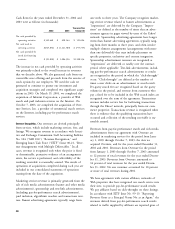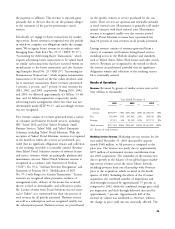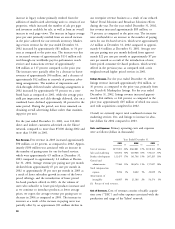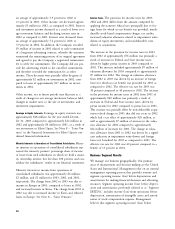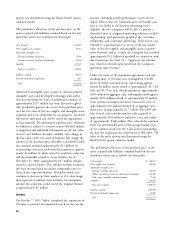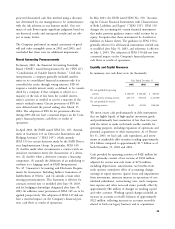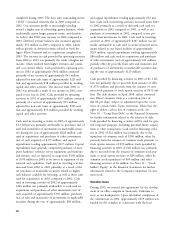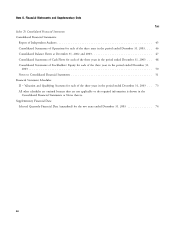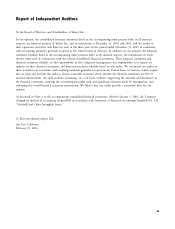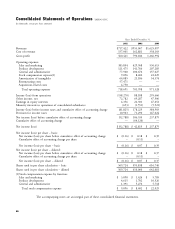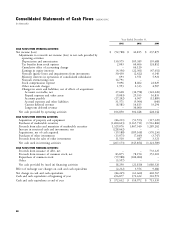Yahoo 2003 Annual Report Download - page 44
Download and view the complete annual report
Please find page 44 of the 2003 Yahoo annual report below. You can navigate through the pages in the report by either clicking on the pages listed below, or by using the keyword search tool below to find specific information within the annual report.accounting for investments in private and publicly-traded adverse changes in these factors could result in losses or
securities; and goodwill and other intangible asset an inability to recover the carrying value of the invest-
impairment. ments that may not be reflected in an investment’s current
carrying value, thereby possibly requiring an impairment
Revenue recognition. Our revenues are primarily generated charge in the future. We recorded approximately $8 mil-
from the sale of rich media advertisements (banner and lion of impairments on the carrying value of equity secu-
other media advertisements), sponsorship, and text-link rities during 2003.
advertisements, including pay-for-performance search
advertisements, paid inclusion and algorithmic searches, Goodwill and Other Intangible Assets. Our long-lived assets
transactions revenue, and revenue generated from a variety include goodwill and other intangible assets. Statement of
of consumer and business fee and listings-based services. Financial Accounting Standards No. 142 ‘‘Goodwill and
In accordance with generally accepted accounting princi- Other Intangible Assets’’ (‘‘SFAS 142’’) requires that good-
ples in the United States, the recognition of these reve- will be tested for impairment at the reporting unit level
nues is partly based on our assessment of the probability (operating segment or one level below an operating seg-
of collection of the resulting accounts receivable balance. ment) on an annual basis and between annual tests in
As a result, the timing or amount of revenue recognition certain circumstances. Application of the goodwill impair-
may have been different if different assessments of the ment test requires judgment, including the identification
probability of collection of accounts receivable had been of reporting units, assigning assets and liabilities to report-
made at the time the transactions were recorded in ing units, assigning goodwill to reporting units, and deter-
revenue. mining the fair value of each reporting unit. Significant
judgments required to estimate the fair value of reporting
Valuation Allowances. We maintain allowances for doubtful units include estimating future cash flows, determining
accounts for estimated losses resulting from the inability appropriate discount rates and other assumptions. Changes
of our customers to make required payments. If the finan- in these estimates and assumptions could materially affect
cial condition of our customers were to deteriorate, result- the determination of fair value for each reporting unit.
ing in an impairment of their ability to make payments,
additional allowances may be required. Effective January 1, 2002, we adopted SFAS 142 and per-
formed a transitional test of our goodwill and intangible
We record a valuation allowance to reduce our deferred assets. Due to, among other things, the overall softening
tax assets to the amount that is more likely than not to be of the global economy and the related decline in interna-
realized. While we have considered future taxable income tional advertising, the Company recorded a goodwill
and ongoing prudent and feasible tax planning strategies impairment loss of $64 million, which was recorded dur-
in assessing the need for the valuation allowance, in the ing the first quarter of 2002 as a cumulative effect of an
event we were to determine that we would be able to accounting change in the Company’s consolidated finan-
realize our deferred tax assets in the future in excess of its cial statements. The fair value of the reporting unit giving
net recorded amount, an adjustment to the valuation rise to the transitional impairment loss was estimated
allowance would likely increase stockholders’ equity as using the expected present value of future cash flows. Any
substantially all of our net operating losses result from further impairment losses recorded in the future could
employee stock option deductions. have a material adverse impact on our financial conditions
and results of operations.
Accounting for investments in private and publicly-traded securities.
We hold equity interests in companies, some of which are Statement of Financial Accounting Standards No. 144
publicly traded and have highly volatile share prices. We ‘‘Accounting for the Impairment or Disposal of
record an investment impairment charge when we believe Long-Lived Assets’’ (‘‘SFAS 144’’), requires that we record
an investment has experienced a decline in value that is an impairment charge on finite-lived intangibles or
judged to be other than temporary. We monitor our long-lived assets to be held and used when we determine
investments for impairment by considering current factors that the carrying value of intangible assets and long-lived
including economic environment, market conditions and assets may not be recoverable. Based on the existence of
the operational performance and other specific factors one or more indicators of impairment, we measure any
relating to the business underlying the investment. Future impairment of intangibles or long-lived assets based on a
38


